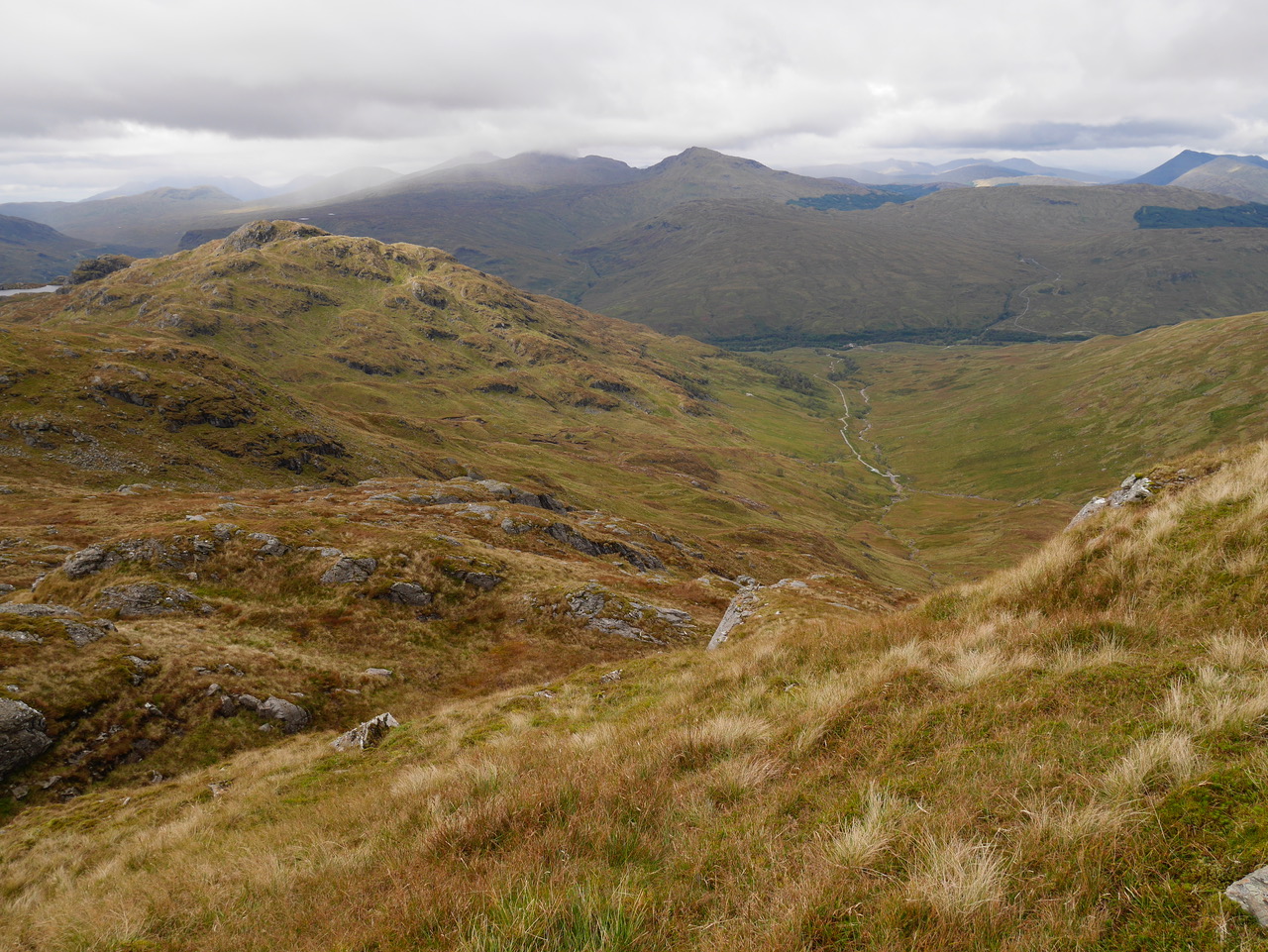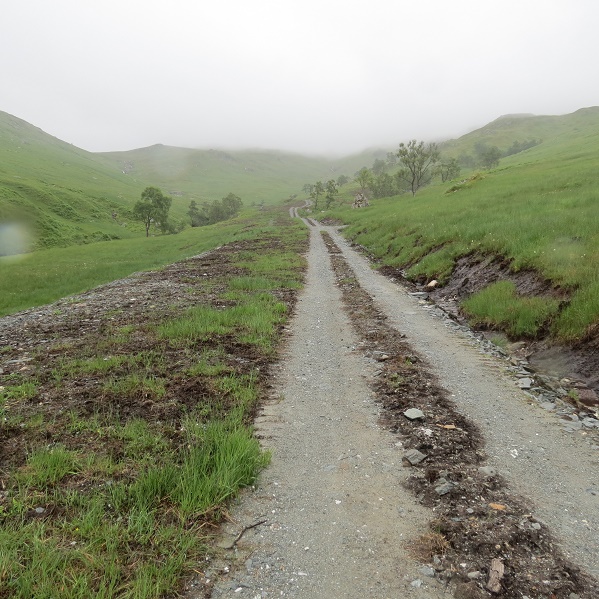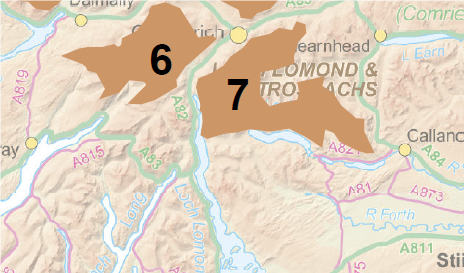
Last Saturday, sitting in a hut in the Snowdonia National Park, I came across a Guardian travel supplement “Adventures in Wild Britain” which featured ten places to experience Britain’s most stunning wildlife. One of the places was Glen Falloch at the head of Loch Lomond (see here).
Regular readers and anyone who hillwalks there, will know that the landscape in Glen Falloch has been trashed by what were supposed to be temporary hydro construction tracks being granted consent by the Loch Lomond and Trossachs National Park Authority to remain on a permanent basis. Of all the new Glen Falloch hydro tracks, the one up the Allt a’ Chuillinn is the least obtrusive in landscape terms from the bottom of the Glen and has been used by the National Park to demonstrate what a good job they are doing.

The quality of the restoration work on the Allt a’ Chuillinn track is indeed better than most of the other Glen Falloch tracks to date but the top photo shows the landscape impact. A harsh artificial line, which is far more prominent than the Allt a Chuillinn itself, which penetrates up into the hills right to the edge of a core wild land area. The LLTNPA officers failed to take this into account when they gave consent under delegated powers to the Glen Falloch Estate to retain this and other tracks.
 Glen Falloch runs between the two Wild Land Areas that have been agreed for the Loch Lomond and Trossachs National Park. Any development in Glen Falloch has obvious implications for wild land areas 6 and 7 but instead of thinking about how these wild land areas might be enhanced, the LLTNPA has allowed tentacles of development to penetrate up all the side glens. Wild Land areas 6 and 7 feel considerably less wild now than they did when they were created three years ago.
Glen Falloch runs between the two Wild Land Areas that have been agreed for the Loch Lomond and Trossachs National Park. Any development in Glen Falloch has obvious implications for wild land areas 6 and 7 but instead of thinking about how these wild land areas might be enhanced, the LLTNPA has allowed tentacles of development to penetrate up all the side glens. Wild Land areas 6 and 7 feel considerably less wild now than they did when they were created three years ago.
You would not know any of this from reading the Guardian article. There is not a mention of the new hydro tracks although it would have been almost impossible for the journalist and photographer to go where they did without seeing some of these tracks. Anyone looking at the photos in the article or reading the purple prose – “We walk for hours and miles for glimpses of deer, but what glimpses” – who didn’t know the area would be left with the impression that Glen Falloch estate is pristine.
The Guardian makes no mention either of the impact of the 700 deer on the estate, whether on the areas of ancient woodland at the bottom of the glen or on the mountain sites of special scientific interest or whether the estate is managing this effectively. The article refers to “the stalker” – I have met him, a nice guy who is very relaxed about access – but it appears nothing has changed since 2013 when in their submission to the Land Reform Review Group (see here) the estate reported it employed one full-time member of staff. Even with occasional part-time assistance one stalker could not possibly “manage” 700 deer effectively. The Landowners however use their staff – who undoubtably work in tough conditions – to sell a message which journalists and politicians find very hard to question.
The promulgation of landowning ideology has always swithered between claiming how many jobs are sustained through their goodwill and current management practices and describing these jobs as precarious (with the implication that any land reform would lead to a total collapse in rural employment). Glen Falloch however now has lots of money because its hydro schemes are operational and generating significant profits. It will be interesting to see if any of this money is used to promote management of the estate in accordance with National Park objectives or even, dare I say it, to promote rewilding in the two wild land areas. One suspects, however, that just like on the grouse moors very little of the money earned by the estate will be re-invested and the tracks, by making it quicker for the stalkers (or gamekeeper) to travel round the estate, will simply enable the estate to keep the number of people they employ to a minimum.
The Guardian article illustrates the extent of the challenge facing proponents of conservation and land reform. Landowning interests are extremely good at manufacturing portrayals of Highlands life for public consumption which are based on images of unspoilt landscape and wildness. These, as in Glen Falloch, conceal the truth as to how the land is actually being managed. Our National Parks should be challenging all of this. My suspicion however is that in this case the LLTNPA’s large marketing team, which is mentioned in the second sentence, set the whole thing up. Unfortunately, the LLTNPA in Glen Falloch is part of the problem, they have been failing to protect the landscape and wild land while doing nothing to promote local employment or to use the hydro schemes as an opportunity to invest in more sustainable forms of land-use. They need to be pressurised to take a different approach in their next 5 year National Park Partnership Plan.

I would be interested to know the what the significant levels of income associated from the hydro scheme area?
Good question. The Glen Falloch accounts are not simple, I have been looking at them and will do a post in due course but planning application for Ben More http://parkswatchscotland.co.uk/2017/07/17/time-take-stand-proposed-new-ben-hydro-track/ gives indication of profit levels (I think Glen Falloch similar though I would like to explain fully why I believe this)